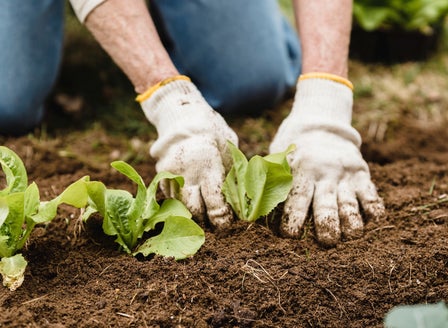Where would Popeye be without his spinach, packed full of essential vitamins and nutrients, Spinach has many great uses in the kitchen either steamed, in salads, on pizza or turned into a vibrant smoothie.
Planting Calendar
Spinach can be planted throughout the year. Plant new plants every two to three weeks for a longer harvesting season.
Harvest In
30-40 days
Harvest leaves from the bottom of the plants regularly as this will encourage continued growth.
Prepare
Position
Spinach likes a rich soil and plenty of sunlight and can be grown in the gardens or in pots
Soil
When planted into the ground spinach likes a free draining soil that is rich in organic matter. To improve the organic content in your soil, break up the soil and add Kings Compost and Kings Sheep Pellets along with some Nature's Organic fertiliser then mix together well. When growing in containers, plant into Living Earth Organic Vegetable Mix with Saturaid added to assist with dispersing water down to the roots.
Plant
Spinach can be sown directly into the garden, raised beds or containers that are at least 30cm deep. Or sown into a seed tray with Organic Seed raising mix and transplanted out once they have formed their second set of leaves. Gently remove the seedling from the tray and plant into the vegetable garden. Space plants 20cm apart so they have plenty of space to grow. Take care when transplanting so that the young soft roots are not damaged. Gently firm the soil down after planting and water in well with Aquaticus Garden Booster, this will help the seedlings settle in.
Care
Watering
Spinach likes to be kept moist, water slowly allowing the water to sink down into the roots, rather than allowing it to run off the top of the soils surface. Add Saturaid into the soil at planting as this will help direct water to the root zone.
Feeding
When planted in the ground liquid feed every month with Aquaticus Garden Booster,, this encourages root growth and increases the microbial activity in the soil. Monthly applications of Kings Sheep Pellets and a side dressing of Nature’s Organic fertiliser will help with soil conditioning and plant health. If planted into a container, feed with Kings Liquid Fast Food
Protecting
Protect young plants from slugs and snails by applying Quash. Re-apply after rain.
Mulching
Mulch around the base of the plants (make sure that the mulch does not come into direct contact with the stem of the plant) with Living Earth More than Mulch. Mulching helps to reduce weeds as well as aiding the soil to retain moisture.
Spraying
If needed spray with Nature's Way Organic Citrus, Veggie & Ornamental Spray
General Care
If needed spray with Nature's Way Organic Citrus, Veggie & Ornamental Spray
Beginner Tip
tagger your planting by planting a new crop every 2-4 weeks for a longer harvesting season. This is referred to as succession planting.
Expert Tip
Water seedling well and after planting to give them a good start.
Top Varieties
Perpetual
A fast growing variety with dark green leaves that holds well.
NZ Spinach
Plant when all signs of frost has passed. The more you pick this trailing variety the more it will produce. Plant 70 cm apart.
Hybrid
A great repeat variety that produces well in winter and spring.
Frequently Asked Questions
What is the best time to plant spinach
The best time to plant spinach is during the cooler months of spring and autumn. Spinach prefers temperatures between 10-20°C, so avoid planting in the heat of summer.
How often should I water spinach?
Spinach likes to be kept moist, water slowly allowing the water to sink down into the roots, rather than allowing it to run off the top of the soils surface. Add Saturaid into the soil at planting as this will help direct water to the root zone.
How much sunlight does spinach need?
Spinach thrives in full sun to partial shade. Aim for at least 4-6 hours of sunlight per day. In hotter months, some afternoon shade can help prevent bolting.
How do I harvest spinach?
Harvest spinach leaves when they are tender and large enough to eat, usually about 4-6 weeks after planting. Pick the outer leaves first, allowing the inner leaves to continue growing for a continuous harvest.
What are common pests and diseases that affect spinach?
Common pests include aphids, leaf miners, and slugs. Diseases like downy mildew and leaf spot can also affect spinach. Regularly inspect your plants and use organic pest control methods when needed.

